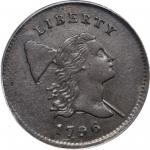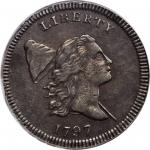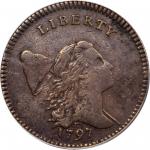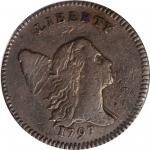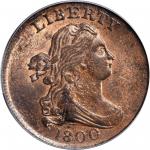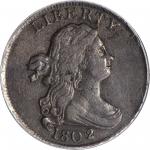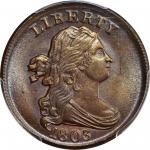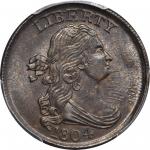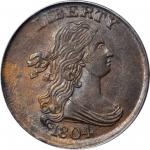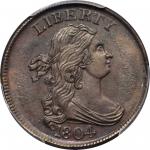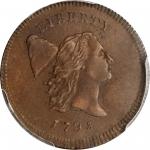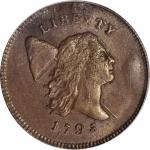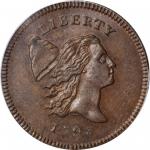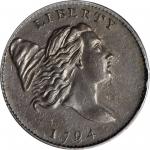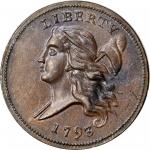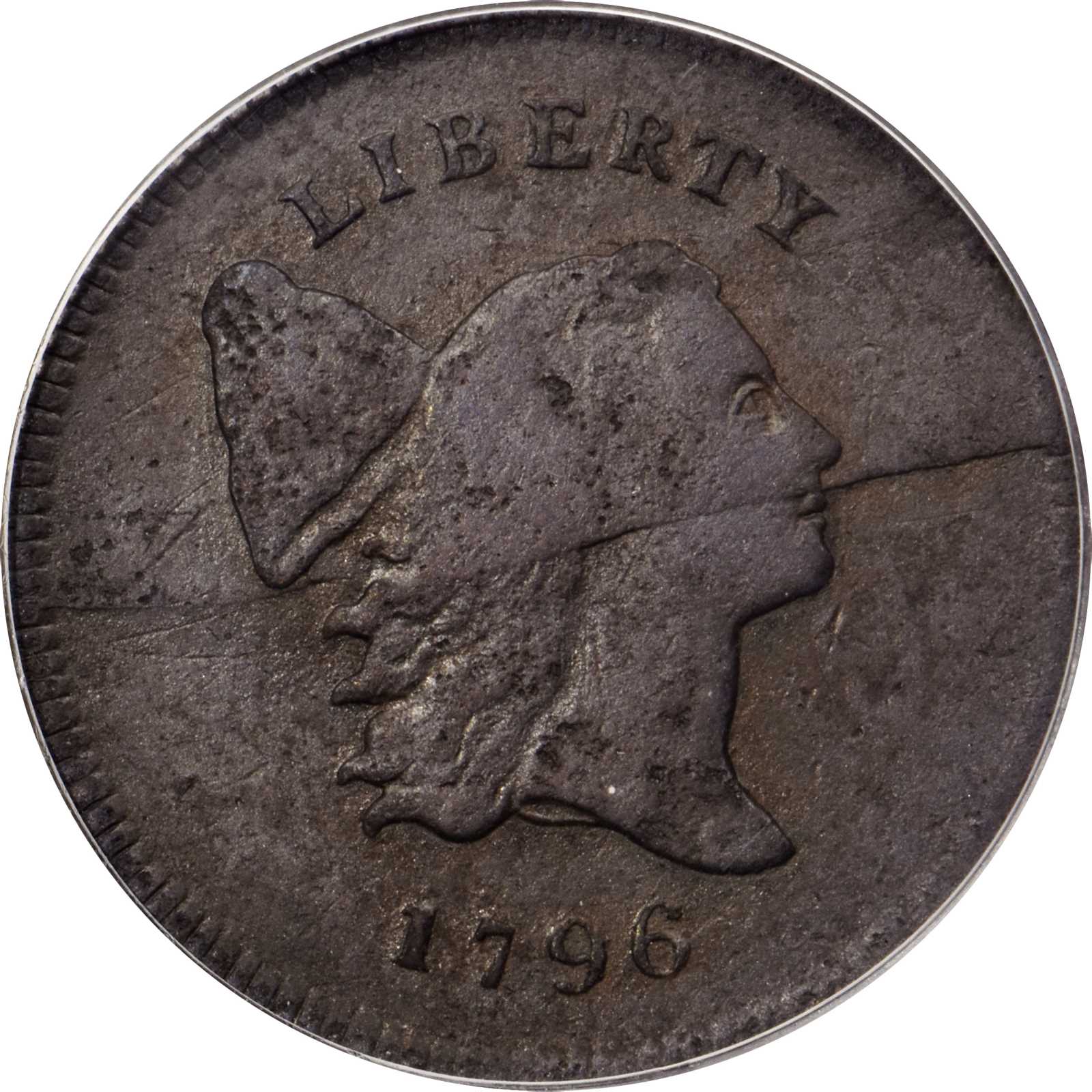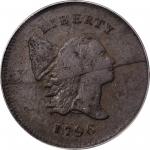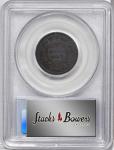1796 Liberty Cap Half Cent. C-1. Rarity-6-. No Pole. VG-10 (PCGS). Type: Type III: Liberty Cap, Head Right, Small Head.Design: Obv: A head of Liberty with flowing hair faces right, a liberty cap and (usually) pole behind. The word LIBERTY is inscribed along the upper border and the date 1796 is below. The portrait on Liberty Cap half cents dated 1795 to 1797 is noticeably smaller than for the Head Right issue of 1794, and it constitutes a distinct type. Rev: A wreath surrounds the denomination HALF CENT, the legend UNITED STATES OF AMERICA around the border and another expression of the denomination, 1/200, below. A ribbon knot with double bow binds the base of the wreath.Weight Standard: 84 grains (5.44 grams). Manley reports a range of 74 to 82 grains from a survey of extant examples of both die varieties of the 1796-dated issue.Diameter: Approximately 23.5 mm.Die Variety: Cohen-1, Breen-1, Gilbert-2. Obv: Instantly recognizable as there is no pole to the cap and a heavy bisecting crack is always present (see below). The digit 1 in the date is normal, i.e., it is not a letter I as used on the obverse die of the 1795 No Pole varieties, proving that the 1796 No Pole was struck from a different die, here in its only known pairing. Rev: Single leaf at the top of each branch in the wreath, four berries on the left branch, three on the right branch; there is a berry on the left side of the bow, but not on the right side. A leaf point is directly below the letter I in UNITED. This die was also used in the 1796 C-2 pairing.Cohen-1 corresponds to the No Pole <em>Guide Book</em> variety of the 1796 half cent.Die State: Manley describes only a single die state for the 1796 C-1 variety. Obv: A heavy crack originates at the border at 2:30 and extends into Libertys portrait between the nose and mouth, continuing into the hair below and behind the ear. A second crack from approximately 9 oclock on the left border extends into the back of Libertys hair just below the cap. Rev: Perfect.Edge: Plain.Mintage: The <em>Guide Book</em> provides a mintage of just 1,390 coins for both varieties of the 1796-dated issue, which corresponds to the Mints delivery of half cents on October 14, 1796. Some numismatic scholars question this total and believe that some or all of the half cents delivered on April 19 (3,350 coins) and/or June 8 (1,740 coins) were also dated 1796. If so, the mintage for this issue could be as high as 3,140 coins (June 8 and October 14 deliveries only) or 6,490 coins (all three deliveries), although a mintage of 1,390 coins is the generally accepted figure.Estimated Surviving Population for the Issue: 100 to 230 coins in all grades.Estimated Surviving Population for the Die Variety: Rarity-6-: 25 to 30 coins in all grades.Strike: Despite a grade of "only" VG-10 from PCGS, this coin retains exceptional detail, as most known specimens of the 1796 No Pole half cent range from awful to wretched. This coin shows full peripheral lettering and design elements, including a well detailed profile of Liberty, most of the peripheral denticulation on both sides, and an exceptionally bold date and denomination. The only softness of note is on the reverse at the letters LF in HALF and the adjacent portion of the wreath, although all of these features are plainly evident.Surfaces: Both sides exhibit dark steely-brown patina, near ebony, with deep olive highlights in areas. While the surfaces are not perfect, with fine granularity yielding to several scattered pits, they are also not unattractive. A few old, dull scratches are noted behind Libertys cap and vertically at the central reverse.Commentary: After only the 1797 Gripped Edge (which is less well known outside of the community of dedicated early copper enthusiasts), the 1796 No Pole is the rarest <em>Guide Book</em> variety in the half cent series. Many numismatists consider this the ultimate half cent, and it has been eagerly sought by collectors since the late 19th century, if not earlier. According to Breen, Dr. Montroville Dickeson knew of the 1796 No Pole in 1859 as he mentioned two varieties of the date. The earliest known auction appearance, however, was in W. Elliott Woodwards October 1880 sale of the Ferguson Haines Collection, lot 416. Mr. Haines had acquired the coin from Scott & Co. two years earlier for $36.Fast forwarding to the late 20th century, the 1796 No Pole became the first half cent to sell for more than half a million dollars when the fabulous Eliasberg specimen realized $506,000 as lot 407 in our (Bowers and Merenas) May 1996 sale of that collection. That coin, universally ranked as CC#1 for the variety, was subsequently certified MS-67 RB by PCGS and brought $763,750 in our February 2016 sale of the D. Brent Pogue Collection, Part III.In the April 2012 issue of <em>Penny-Wise</em> (journal of the Early American Coppers Club), Michael Spurlock accounted for 26 positively identified discrete specimens from these dies, along with several other untraced auction appearances over the last 150 years. Just nine specimens were reported in the 2005 1/200 survey of notable half cent collections, and only two examples were displayed during this varietys EAC Half Cent Happening appearance in 2014. A few other Mint State examples rank behind the Eliasberg-Pogue specimen in the Condition Census, including the Missouri Cabinet specimen (PCGS MS-65 BN), the John Whitney Walter coin (Choice Mint State) and the "Anderson-Dupont" piece that currently resides in the Jim McGuigan Collection (PCGS MS-63 BN). Nevertheless, the vast majority of survivors are in the lowest collectible grades, mostly dark, worn, corroded, and lacking visual appeal. None can fairly be called well worn but choice. The present example may not be choice, but it retains plenty of bold to sharp striking detail and presents quite well overall. This variety is a legendary rarity, and any example would serve as a highlight in an advanced cabinet; even some of the most highly regarded collections have lacked one. Roger Cohens personal coin, a rough AG deemed "satisfying" in his 1992 auction sale, later turned out to be a counterfeit but was included in the J.R. Frankenfield sale as a space filler. Bill Weber also lacked this variety, and Dr. Lees coin was a rough AG that served John Whitneys set until he was able to acquire the aforementioned Choice Mint State example. Few great half cent cabinets of the past have had a coin that compared to this one in terms of remaining detail and overall eye appeal, and even fewer had one that stood out as clearly better than this example. A highlight of the remarkable ESM Collection of Half Cents, and sure to see spirited bidding at auction.The extreme rarity of this variety can be laid at the feet of the diagnostic crack, which probably occurred during or shortly after the device punch with Libertys portrait and the cap was used to prepare the obverse die. The pole was not included in the device punch and would have been added to the die separately. But with the crack resulting in what must have seemed like an unusable die, the engraver probably chose to not waste any further time adding the pole to complete the die. Since the obverse die of the 1796 C-2 variety is not known to have suffered any terminal damage that would have resulted in its early retirement from production, Mint personnel probably found themselves in the unexpected position of having to use the cracked and incomplete obverse of the C-1 as a stopgap measure until the C-2 obverse die could be readied for coinage. Although this makes sense, it is conjecture as the emission sequence for this issue is unknown. There are simply too few coins extant for both the C-1 and C-2 varieties to provide sufficient data on die states. Regardless, the majority of 1796 half cents struck were from the C-2 die pairing with pole. From the ESM Collection. Earlier from our (Stacks and American Numismatic Rarities) Medio and Da Costa Gomez Collections sale, June 2004, lot 2083. The coin was certified Fine-15 by ANACS at the time of that sale, and our cataloger further noted that it had previously been certified both Fine-15 and Fine-12 by PCGS. The PCGS Fine-12 insert that accompanied our offering in June 2004 is not included here.

